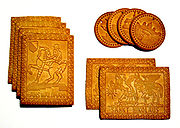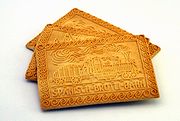
Tirggel
Encyclopedia

Christmas
Christmas or Christmas Day is an annual holiday generally celebrated on December 25 by billions of people around the world. It is a Christian feast that commemorates the birth of Jesus Christ, liturgically closing the Advent season and initiating the season of Christmastide, which lasts twelve days...
biscuits from Zürich
Zürich
Zurich is the largest city in Switzerland and the capital of the canton of Zurich. It is located in central Switzerland at the northwestern tip of Lake Zurich...
, Switzerland. Made from flour
Flour
Flour is a powder which is made by grinding cereal grains, other seeds or roots . It is the main ingredient of bread, which is a staple food for many cultures, making the availability of adequate supplies of flour a major economic and political issue at various times throughout history...
and honey, they are thin, hard, and sweet.
History
Tirggel-like honey cakes were already popular in antiquity. The earliest known baking moulds for similar pastries date to 3rd millennium BC3rd millennium BC
The 3rd millennium BC spans the Early to Middle Bronze Age.It represents a period of time in which imperialism, or the desire to conquer, grew to prominence, in the city states of the Middle East, but also throughout Eurasia, with Indo-European expansion to Anatolia, Europe and Central Asia. The...
Mesopotamia
Mesopotamia
Mesopotamia is a toponym for the area of the Tigris–Euphrates river system, largely corresponding to modern-day Iraq, northeastern Syria, southeastern Turkey and southwestern Iran.Widely considered to be the cradle of civilization, Bronze Age Mesopotamia included Sumer and the...
. The recipe is believed to have come to northern Europe with the conquests of the Roman Empire
Roman Empire
The Roman Empire was the post-Republican period of the ancient Roman civilization, characterised by an autocratic form of government and large territorial holdings in Europe and around the Mediterranean....
. In what is today Switzerland, tirggel are said to have been used as pagan
Paganism
Paganism is a blanket term, typically used to refer to non-Abrahamic, indigenous polytheistic religious traditions....
offertory
Offertory
The Offertory is the portion of a Eucharistic service when bread and wine are brought to the altar. The offertory exists in many liturgical Christian denominations, though the Eucharistic theology varies among celebrations conducted by these denominations....
cakes, cut in the shape of sacrificial animals.
Tirggel are first recorded in Zürich as Dirgel in 1461. They have been manufactured there ever since with elaborately carved wooden moulds depicting Biblical or regional themes. More recently, the wooden moulds—four of which are exhibited in the Swiss National Museum
Swiss National Museum
The Swiss National Museum — part of the Musée Suisse Group, itself affiliated with the Federal Office of Culture — is one of the most important art museums of cultural history in Europe and the world...
—have been replaced by polycarbonate
Polycarbonate
PolycarbonatePhysical PropertiesDensity 1.20–1.22 g/cm3Abbe number 34.0Refractive index 1.584–1.586FlammabilityV0-V2Limiting oxygen index25–27%Water absorption – Equilibrium0.16–0.35%Water absorption – over 24 hours0.1%...
casts, which are easier to handle.
Preparation
Tirggel dough is composed of flour, 29 percent honey, some sugar and water; although one source reports that it is or was made without sugar, which is taken to be an indication of the tirggelThe dough is pressed very thinly into elaborately carved moulds of varying shapes and sizes; the tirggel can be as large as windowpanes. The biscuits are baked in a high-temperature oven at 400 °C (752 °F) for only 90 seconds and require good timing to get right.
Consumption
Because tirggel are hard and dry, they are best when sucked on for a while, allowing the honey flavour to become more pronounced.Tirggel are also very durable. Swiss writer Emanuel Stickelberger reported in 1939 that "the tirggel has the admirable quality of not becoming stale, and the harder it gets, the more enjoyable is it to nibble on." On account of their elaborate ornamentation, traditionally manufactured tirggel are often not eaten at all for months or years and are kept as decorations instead.
Further reading


